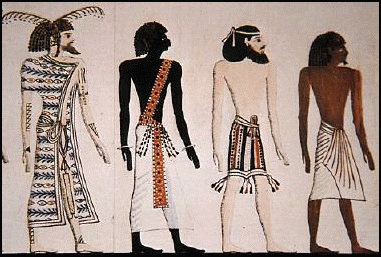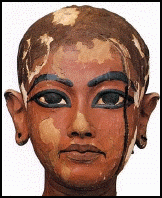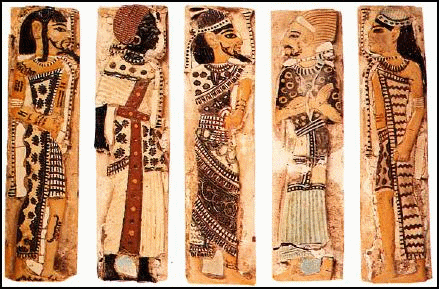Syrian, Nubian, Libyan, and Egyptian.

From the tomb of Seti I.
Four peoples of the world:
Syrian, Nubian, Libyan, and Egyptian.

From the tomb of Seti I.
Race is a notoriously nebulous concept. Before a physical property can be scientifically examined, it must be objectively defined so that accurate measurements of variables can be made. Defining race has been based on subjective taxonomic classification, morphological interpretation, and physiognomic characteristics, exercises that are frighteningly akin to phrenology. Race has yet to be defined in objective genetic terms that are quantifiably measurable, rendering attempts at truly scientific discussion hopelessly futile.
The fact remains that the human race is of a single species. Historically, races were first assumed to exist, then they were recognized, then described, and lastly classified, an unscientific and arbitrary method at best. Race was first applied to the realm of natural history in 1749 when Buffon described six groups of man. Critics came early and in 1784, Herder wrote:
Some for instance have thought it fit to employ the term races for four or five divisions, originally made in consequence of country or complexion: but I see no reason for this appellation. Race refers to a difference of origin, which in this case does not exist, or in each of those countries, and under each of these complexions, comprises the most different races... In short, there are neither four or five races, nor exclusive varieties, on this Earth. Complexions run into each other: forms follow the genetic character: and upon the whole, all are last but shades of the same great picture, extending through all ages, and over all parts of the earth. They belong not, therefore, so properly to systematic natural history, as to the physicogeographical history of man. [von Herder, Johann Gottfried, Ideas Toward a Philosophy of History, 1784]
If race as a classification had any use at all, it served as a mere convenience to distinguish between geographic groups of people. In the process, individual variances must first be abolished and the group's characteristics reduced to an average, to an imaginary prototype if you will, that has no basis in physical genetic reality. Writes Montague:
To sum up, the indictment of the anthropological conception of race is (1) that it is artificial; (2) that it does not agree with the facts; (3) that it leads to confusion and the perpetuation of error, and finally, that for all these reasons it is meaningless, or rather more accurately such meaning as it possesses is false. Being so weighed down with false meaning it were better that the term were dropped altogether than that any attempt should be made to give it a new meaning. [Montague, Ashley, ed. The Concept of Race, 1964, p. xv]
Geneticist Steven Rose said,
Biologists define "race" as a group or population differing in gene frequency from that of others in the same species. Such differences usually occur as a result of some type of geographic barrier limiting interbreeding, so that the two otherwise similar genetic populations begin to drift apart. Thus there are distinct "races" of fruit flies – separated perhaps by mountainous or desert conditions. However, with very limited exceptions there are no such separated groups within the human population, and those that do occur do not map on to what are in conventional speech regarded as separate "races." The consensus view among population geneticists and biological anthropologists is that the concept of "race" to indicate analytically distinct subgroups of the human race is biologically meaningless. [From a public lecture given at Gresham College, London, reported in The Independent, 28 January 2002]
"Race is a social construct, not a scientific classification," Robert S. Schwartz, M.D. wrote (in "Race Is a Poor Measure," New England Journal of Medicine, Vol. 344, No. 18, May 3, 2001). "Any attempt to establish lines of division among biological populations is both arbitrary and subjective." The Human Genome Project determined that 99.9% of the human genetic complement is the same in everyone, regardless of race. This means that the DNA of any two people will differ in one out of every thousand nucleotides, the building blocks of individual genes. With more than 3 billion nucleotides in the human genome, about 3 million nucleotides will differ among individuals. While statistically small, this does allow for some variation. "Admittedly," wrote Dr. Sally Satel, "race is a rough marker. A black American may have dark skin - but his or her genes may well be a complex mix of ancestors from west Africa, Europe and Asia. No serious scientist, in fact, believes that genetically pure populations exist. Yet an imprecise clue is better than no clue at all." ("A question of colour" in The Guardian, 9 May 2002) But these differences between people are relatively insignificant: skin pigment, eye shape, and hair texture. The physical "stereotypes" of race, Luigi Luca Cavalli-Sforza wrote in The History and Geography of Human Genes, "reflect superficial differences."
Tutankhamun

© Photo copyright Francesco De Luca,
in Tiradritti, Egyptian Treasures,
1999, p. 205
This said, we might ask, "What color were the ancient Egyptians?" Being on the continent, Egypt has always been an African civilization though it straddles two regions, Africa and the Middle East. It's fairly clear that the cultural roots of ancient Egypt lie in Africa and not in Asia. Egypt was a subtropical desert environment and its people had migrated from various ethnic groups over its history (and prehistory), thus it was something of a "melting pot," a mixture of many types of people with many skin tones, some certainly from the Sub-Saharan regions and others from more Mediterranean climes. It is impossible to categorize these people into the tidy "black" and "white" terms of today's racial distinctions. The Egyptians are better classified using evidence of their language and their material cultures, historical records, and their physical remains because so-called "racial" identification has been elusive, much for the reasons cited above. Skulls have been measured and compared and DNA tests attempted in various forms, but conclusions are few. Skulls are more similar to those found in the Northern Sudan and less similar to those found in West Africa, Palestine, and Turkey. It seems that there has been some genetic continuity from Predynastic time through the Middle Kingdom, after which there was a considerable infiltration into the Nile Valley from outside populations. That the Egyptians by and large were dark is certain, and many must have been what we today call "black."
Tutankhamun

© Photo copyright Francesco De Luca,
in Tiradritti, Egyptian Treasures,
1999, p. 230
It is apparent that the ancient Egyptians did not make racial distinctions themselves, but rather ethnic distinctions based on nationality. Tomb paintings depicting captive Nubians may show them as being very dark, but this is an artistic convention stereotyping a nationality, and to conclude there were therefore no very dark Egyptians would be a non sequitur. Similarly, the skin tones in art depicting the Egyptians themselves adhere to convention rather than an absolutely accurate description of reality. Tutankhamun is variously shown as being black as in the guardian statues found in his tomb, and brown or beige as in the lotus bust (see photos above).
There has been a spate of controversy of late between "Afrocentric" authors and their critics, but the truth is that Egyptologists are not involved in some massive conspiracy of lies designed to subjugate black populations, as has often been charged. Indeed, most modern Egyptologists are rather taciturn when it comes to the subject of race. Nor have the black Africans been "robbed" of their legacy. Civilization as it exists today is the culmination of the historical development of mankind, layer upon layer from ancient times to modern, each group contributing its share to the whole. Through human interaction, whether by trade or warfare, ideas, reform, and invention are assimilated, adapted, and again dispersed. It's the nature of history regardless of ethnicity. To make petty and arbitrary distinctions based on human physical appearance is divisive and can only lead to wanton racist misuse. No good can come of it beyond establishing immediate and limited familial ties; beyond this the discussion of race has no place in science. We can safely conclude that the ancient Egyptians were of various skin colors, few of which were light judging by the climate.
Foreign prisoners of Ramesses III:
Libyan, Nubian, Syrian, Shasu Bedouin, and Hittite.

Faience tiles from the royal palace at Medinet Habu.
In the 1940's, A. Batrawi made a detailed examination of ancient skeletal material from Egypt and Lower Nubia, comparing such physical features as craniological data and the length of limb bones, while recording changes through time. His resulting theory of racial continuity in the early Egyptian population has been supported by more recent research. In his seminal two-part article "The Racial History of Egypt and Nubia" (The Journal of the Royal Anthropological Institute, 75:1945, pp. 81-101; 76:1946, pp. 131-56), Batrawi does categorize physical types into racial groups, but his description of migration and interaction remains valid. He concluded:
Since early neolithic times there existed two distinct but closely related types, a northern in Middle Egypt and a southern in Upper Egypt. The southern Egyptians were distinguished from the northerners by a smaller cranial index, a larger nasal index and greater prognathism. The geographical distinction between the two groups continued during the Pre-Dynastic Period. The Upper Egyptians, however, spread into lower Nubia during that period. By the beginning of the Dynastic era the northern Egyptian type is encountered for the first time in the Thebaïd, i.e., in the southern territory. The incursion, however, seems to have been transitory and the effects of the co-existence of the two types in one locality remained very transient until the 18th Dynasty. From this time onwards the northern type prevailed all over Egypt, as far south as Denderah, till the end of the Roman period.In Lower Nubia a slight infiltration of negroid influence is observed during the Middle Kingdom times. In the New Empire period, however, the southern Egyptian type prevails again. After the New Empire a fresh and much stronger negro influence becomes discernable till the end of the Roman period.
There is a wide gap in our knowledge of the racial history of the two countries during the Christian and Islamic periods, owing to the lack of an adequate amount of relevant material. The study of the available measurements of the living, however, apparently suggests that the modern population all over Egypt conforms more closely to the southern type. The mean measurements for the modern Nubians are rather curious. The average cephalic index for them is significantly larger than that for the Egyptians. This is contrary to expectation based on knowledge of the characteristics of the ancient populations. No satisfactory explanation could be suggested.
The distribution of blood groups in present-day Egypt shows that the mass of population is very homogeneous and there are no significant differences, in this respect, between the Moslems and the Copts. Comparisons of head and body measurements suggest the same conclusion. [pp. 154-55]
Catchpenny Mysteries © copyright 2000 by Larry Orcutt.